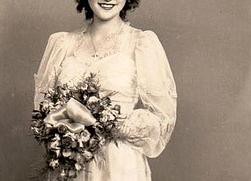Name That Bride, Part Two
by Sarah Marshall

A. “A strapless Vera Wang gown and flip-flops.”
B. “A nipped-at-the-waist dress created by Mainbocher in what was termed [the bride’s] signature color of … blue reportedly to match her eyes. Her coordinating straw hat, by Caroline Reboux, had a halo effect with pale blue tulle and her matching gloves were created from the same blue silk crepe as her dress. [Thirteen years after the wedding, the bride] presented the dress to the Metropolitan Museum.”
C. “A dark blue outfit, which for years after was a serviceable lab garment.”
D. “Given the hour, the justice [of the peace] was wearing pajamas and a bathrobe. [The bride], dressed for a date, was wearing a little navy blue dress trimmed in red with matching jacket and suede shoes.”
E. “A beige suit, ruffled white blouse, and a veil.”
F. A gown “cut from luminous, white-hued cloth-of-silver: the traditionally prescribed material … enhanced by masses of exquisite white diamonds, which [the bride] had received as wedding gifts from her mother … The ensemble would have been a masterpiece but for one tiny detail … the dressmakers who had confected the wedding gown had misestimated [the bride’s] measurements, and cut the bodice far too small.”
G. The bride “wore a lovely white muslin dress” and “neither a veil nor flowers in her hair.”
H. The bride wrote that she “wore gray because this was my second marriage, but on top I wore a white silk blouse with lace on the collar and sleeves.” The bride’s dog “wore a small hat … with pink streamers.”
I. The bride looked “like a snowdrop” in a dress made of “white embroidered muslin, with a lace mantle, and white bonnet trimmed with green leaves.”
J. “A blue velvet dress topped off with a blue velvet hat decorated with a white ostrich feather,” which the bride continued to wear to various public functions throughout her career.
K. A “white, dotted tulle Alita Graham retrofitted with lace sleeves and a sweetheart neckline to conform to Mormon standards.”
L. “A gold damask dress trimmed with lace, over a petticoat of fine white fabric decorated with silver threads … along with purple satin slippers embellished with silver metallic thread and sequins, and pearl jewelry.”
M. The bride baked the cake and made the dress herself, saying of it that “I had decided it was to look as little like a wedding dress as possible, yet not be so plain as to be pointless. I settled on a caftan, made out of a loosely woven white material, with angel sleeves, onto which, the last morning, so that no one but I saw it before the ceremony, I was going to stitch a hood.”
N. The bride wore “a light blue short lacy dress” and had “light blue flowers in her hair.”
O. The bride’s “dress was white silk taffeta — off the shoulders but with sleeves capped just above the elbow. The rusching of the fitted bodice opened up into beautiful open folds of the skirt that draped on the floor. Amazing beading was at the neck and waist.” The bride wrote that “the wedding planner had convinced me to tone down my love of purple a little.”
P. A “pink wool knitted dress” made for the bride by her mother.
Q. The bride wrote that she “wore a silk, off-white dress that I’d bought in Toronto, and I was wearing flowers in my hair. It rained all morning and most of the day, which was considered good luck. It doesn’t seem like it now … That night [we] danced our first real waltz … We were not good dancers on the floor, I can definitely say this.”
R. The bride went barefoot, and wore a “loose, floor-length white sheath” that, according to one of the groom’s relatives, “looked more like a slip that should go under a wedding dress,” and “a floor-length piece of tulle that held her hair back off her forehead.”
S. An “embroidered Swiss organdy gown and matching hat” that the bride had made herself.
T. The bride “wore a simple white satin gown with a white crocheted Juliet cap, looking even younger than her nineteen years. As soon as the ceremony was over, [she] removed her wedding band to show it to friends and relives. This gesture made [her mother] extremely upset.”
***
1. Maria Antonia Josepha Johanna, Archduchess of Austria (later known as Marie Antoinette), to Louis-Auguste, Dauphin of France (later known as Louis XVI)
2. Charlotte Brontë to Arthur Bell Nicholls
3. Ekaterina Gordeeva to Sergei Grinkov
4. Elizabeth Smart to Matthew Gilmour
5. Mary Todd to Abraham Lincoln
6. Gilda Radner to Gene Wilder
7. Julia Roberts to Lyle Lovett
8. Wallis Simpson to Edward, Duke of Windsor
9. Rita Hayworth to Orson Welles
10. Martha Kostyra to Andrew Stewart
11. Margaret Roberts to Denis Thatcher
12. Sarah Michelle Gellar to Freddie Prinze, Jr.
13. June Carter to Johnny Cash
14. Margaret Sinclair to Pierre Trudeau
15. Sylvia Plath to Ted Hughes
16. Marie Skłodowska to Pierre Curie
17. Vivian Hartley (later known as Vivien Leigh) to Leigh Holman
18. Marlee Matlin to Kevin Grandalski
19. Martha Dandridge Custis to George Washington
20. Lana Turner to Artie Shaw
Answers: 1=F, 2=I, 3=Q, 4=K, 5=G, 6=H, 7=R, 8=B, 9=E, 10=S, 11=J, 12=A, 13=N, 14=M, 15=P, 16=C, 17=T, 18=O, 19=L, 20=D
Previously: Part One (“I had to be the ugliest bride you ever saw”).
Sarah Marshall’s fiction has most recently appeared in Hayden’s Ferry Review.
Photo via Flickr/artbyheather